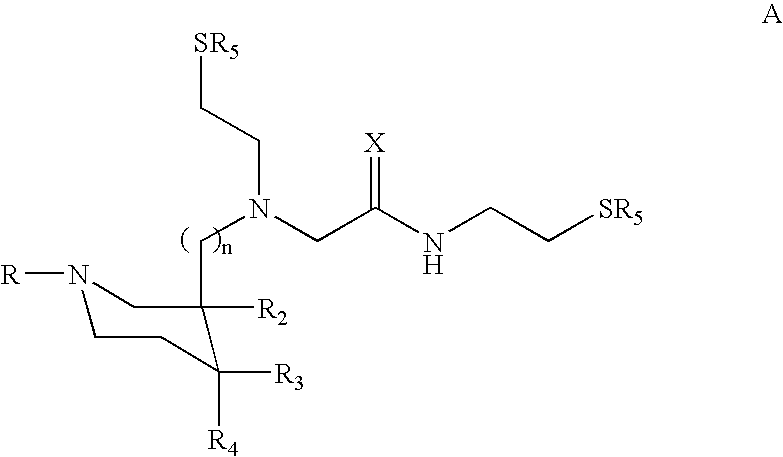Imaging agents for diagnosis of Parkinson's disease
a technology of dopamine transporter and imaging agent, which is applied in the field of central nervous system dopamine transporter imaging agent for diagnosis of parkinson's disease, can solve the problems of ineffective screening of pet owners, difficult development of radiolabeled ligands for spect imaging of dat, and low absolute brain uptake of this agen
- Summary
- Abstract
- Description
- Claims
- Application Information
AI Technical Summary
Problems solved by technology
Method used
Image
Examples
example 1
Synthesis of a Series of Novel Piperidine Monoamine Transporter Ligands
[0347]Our proprietary piperidine monoamine transporter ligands, while sharing a structure activity relationships with the related tropanes, are more readily prepared in isomeric and enantiomeric forms allowing us access to a large range of monoamine selectivities. As this selectivity is highly dependant on a number of factors including the orientation of the C-3 ester, as well as the absolute configuration of the ligand, we will prepare both enantiomers of each isomer (Scheme 2) under the conditions utilized in the preliminary studies. The trans-(+) isomer [(+)-10] is readily prepared from the corresponding cis-(−) isomer [(−)-1] by the base catalysed epimerization.8
[0348]
[0349]Based on preliminary studies in which the “3+1” methodology was employed utilizing the N-propylthiol analog of MTPT demonstrated excellent brain uptake, we will prepared a second series of compounds with the N2S2 chelating unit tethered t...
example 2
Preparation of Rhenium-Piperidine Complexes
[0351]The properties of the Group VII metals technetium and rhenium are very similar due to their periodic relationship. It is anticipated that the metals will demonstrate similar reaction chemistry, which is often the case for the thiol, nitrogen, phosphine and oxo-chemistry of these two metals. Likewise, perrhenate and pertechnetate have very similar reaction behaviors.28 The similar reductions of the M(VII) oxo species by SnCl2 allow for easy substitution of the nonradioactive rhenium as a model for the medicinally useful technetium-99m, which routinely uses tin reduced 99mTc. Synthesizing the rhenium-piperidine complexes will allow us a facile route to structurally characterize the products. The characterized products can then be used for in vitro pharmacological studies. The periodic relationship between Tc and Re further indicates that Tc-99m radiopharmaceuticals can be designed by modeling analogous rhenium complexes.29
[0352]The syn...
example 3
In Vitro Pharmacological Studies on Piperidine Ligands and the Corresponding Rhenium Complexes
[0355]The pharmacological profile for each of the rhenium-oxo complexes, as well as the free ligands will be determined by the binding affinities at each of the monoamine transporters. The binding affinity at DAT (human recombinat, expressed in CHO cells) will be determined by its ability to displace 0.15 nM [125I]RTI-55.36 The binding affinity at NET (human recombinat, expressed in MDCK) will also be determined by the ability of the complexes to displace 0.20 nM [125I]RTI-55.37 The binding affinity at 5-HTT (human recombinat, expressed in HEK-293) will be determined by its ability to displace 0.15 nM [125I]RTI-55.36 All compounds will initially be tested at 10−6 M (in duplicate) and compounds that exhibit displacement of >40% will be assayed (at 10−7, 10−8, 10−9 M in duplicate) and approximate IC50 values are calculated.
PUM
| Property | Measurement | Unit |
|---|---|---|
| pH | aaaaa | aaaaa |
| pH | aaaaa | aaaaa |
| time | aaaaa | aaaaa |
Abstract
Description
Claims
Application Information
 Login to View More
Login to View More - R&D
- Intellectual Property
- Life Sciences
- Materials
- Tech Scout
- Unparalleled Data Quality
- Higher Quality Content
- 60% Fewer Hallucinations
Browse by: Latest US Patents, China's latest patents, Technical Efficacy Thesaurus, Application Domain, Technology Topic, Popular Technical Reports.
© 2025 PatSnap. All rights reserved.Legal|Privacy policy|Modern Slavery Act Transparency Statement|Sitemap|About US| Contact US: help@patsnap.com



